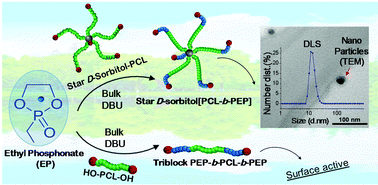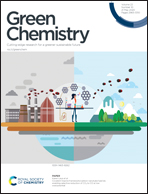Clean synthesis of linear and star amphiphilic poly(ε-caprolactone)-block-poly(ethyl ethylene phosphonate) block copolymers: assessing self-assembly and surface activity†
Abstract
Anionic ring-opening polymerization (AROP) of 2-ethyl-2-oxo-1,3,2-dioxaphospholane (EP) has been utilized to create alternative hydrophilic moieties for utilization in surfactants. The current “go-to” hydrophilic unit is poly(ethylene glycol) (PEG), but this is non-biodegradable and there is some evidence that its use can lead to accumulation of toxic by-products. We have created new approaches leading to water-dispersible, fully degradable amphiphilic block copolymers. Our approach utilized poly(ε-caprolactone)-based macroinitiators in a solvent free process with organocatalyst DBU. We have prepared a comprehensive set of novel amphiphilic PCL-b-PEP block copolymers including linear diblock, triblock and star diblock copolymers characterized by SEC, 1H and 31P NMR and MALDI-TOF analyses. Supercritical carbon dioxide (scCO2) was exploited to efficiently extract the residual EP monomer leading to significantly increased gravimetric yields of purified product compared to conventional techniques such as dialysis. The self-assembly of the amphiphilic copolymers in water was investigated by DLS and cryo-TEM and their surface-activity as a function of concentration was investigated by tensiometry showing behavior that matches or exceeds commercially available surfactants.



 Please wait while we load your content...
Please wait while we load your content...